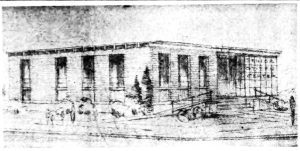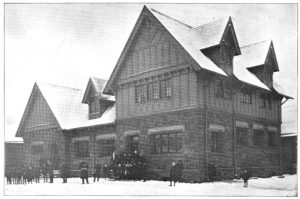At the end of the 1800s, the Polish population of Buffalo neared 80,000. Many of these Poles lived in tenement conditions, with four, five, or six families to a house and personal hygiene was an issue Heath Commissioner Wende was concerned with. In 1897, Buffalo opened a free public bath house on the Terrace which found great success in the nearby Italian tenement. With that, Commissioner Wende began laying down the ground work for a second free bathhouse to be located in the Polish district.
 The project began slowly when a corner lot at Stanislaus Street and Woltz Avenue was purchased in 1898. In March of the next year, Alderman Frank Cwiklinski earmarked $15,000 in the budget for the project and Buffalo Bath House No. 2 was born. The architectural firm of Lansing & Beierl was hired to design the house and construction began in early 1900. As the building was being finished Michael Lauber was named Keeper of the House with Michael Wozniak as his assistant. On January 2, 1901, the new bath house was formally opened and 350 people used the facility that first day.
The project began slowly when a corner lot at Stanislaus Street and Woltz Avenue was purchased in 1898. In March of the next year, Alderman Frank Cwiklinski earmarked $15,000 in the budget for the project and Buffalo Bath House No. 2 was born. The architectural firm of Lansing & Beierl was hired to design the house and construction began in early 1900. As the building was being finished Michael Lauber was named Keeper of the House with Michael Wozniak as his assistant. On January 2, 1901, the new bath house was formally opened and 350 people used the facility that first day.
Open from 7:00 AM to 9:00 PM, the brick and stone frame structure was outfitted with 18 individual showers, nine rain baths in three apartments, and one bathtub. The building was also separated into two sections, one for the men and the other for the women, allowing each a 20 minute shower. The new bath house was extremely popular with the Poles; in the first 15 days nearly 5,000 people used the baths exceeding both Health Department’s expectations and budget. Soon more money was allocated for supplies and assistants. With its size and popularity the bath house quickly became a community center. This allowed to city to save money by transferring the East Side vaccination station there and opening it as a polling place for elections.
 In 1916, 230,901 individuals were using Bath House No. 2 and as Polish Buffalo continued its expansion, more bath houses were requested. This led to the opening of the Bath House No. 3 at Grant and Amherst Streets in Polish Black Rock. By 1929, they were seeing 1,000 individuals a day come through their doors to bathe and do laundry. With so many people, the Keepers of the House had their fingers on the pulse of the neighborhoods. John Redman who managed House No. 2 in 1937 knew the health of the East Side economy based on towel rentals. “In good times, we rent more than 1,000 a week. Right now, we aren’t renting 150 a week. When money is scarce, folks bring their own towels.”
In 1916, 230,901 individuals were using Bath House No. 2 and as Polish Buffalo continued its expansion, more bath houses were requested. This led to the opening of the Bath House No. 3 at Grant and Amherst Streets in Polish Black Rock. By 1929, they were seeing 1,000 individuals a day come through their doors to bathe and do laundry. With so many people, the Keepers of the House had their fingers on the pulse of the neighborhoods. John Redman who managed House No. 2 in 1937 knew the health of the East Side economy based on towel rentals. “In good times, we rent more than 1,000 a week. Right now, we aren’t renting 150 a week. When money is scarce, folks bring their own towels.”
As housing became more available the necessity of the bath houses diminished. In the 1940s Stanley Molik became keeper of House No. 2 and although improvements were made, attendance declined. On July 1, 1962 the city of Buffalo closed down the bath houses and required all city apartments to have baths. This led to some unintended consequence as renters like Henry Bauman of 94 Woltz Avenue were forced to move, often to the suburbs taking their rent money with them.
Now with a piece of unused property in the heart of the East Side, the city decided to erect Senior Center for the aging Polish population. On March 3, 1969, the Ulinski Senior Center, named in honor of parks commissioner, Common Council president and International Boundary Commission member, John A. Ulinski was dedicated. In 2015, the building was home to Buffalo Markaz Masjid.
Do you have any stories or memories about this location of the Polonia Trail? We would love to hear it! Please send us your story, and if it is chosen, it will be added to the site.
Send Your Story